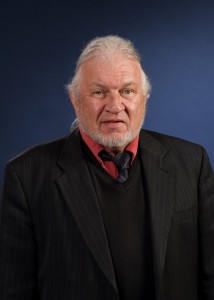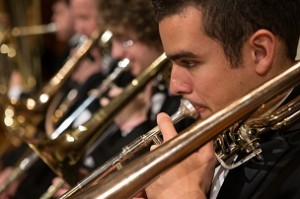
Professor of music Douglas Weeks
will direct the Brass Ensemble
and Orchestra in a performance
of Symphony No. 3 by
Camille Saint-Saëns.
It’s a work usually reserved for professionals, but these WPI students are ready for the challenge. Symphony No. 3 by Camille Saint-Saëns is commonly referred to as the “Organ Symphony” because, well, the organ is the heart and soul of the piece.
The WPI Orchestra, along with organist William Ness, will present the monumental composition this weekend. The WPI Brass Ensemble will open the program. The “Organ Symphony” is the third and last of the Saint-Saëns symphonies. At its completion, he ranked it among his best. “I gave everything to it I was able to give,” he said. “What I have here accomplished, I will never achieve again.”
The Symphony No. 3 is a rare gem of the 19th century classical repertoire, deserving wider attention. True, it is a challenging piece, yet ultimately satisfying. Critic Tom Service considers one of the crowning glories of the composer’s prodigious musical career. Assessing the work, he wrote: “I make a plea that we take the Organ Symphony seriously as one of the late 19th century’s most significant and technically sophisticated orchestral works.”
Who: William Ness, organ; Olga Rogach, piano; Malcolm Halliday, piano; and the WPI Orchestra and WPI Brass Ensemble, directed by Douglas Weeks
What: Symphony No. 3 by Camille Saint-Saëns
Where: First Baptist Church, 111 Park Ave., Worcester
When: Sunday, Nov. 16, 3 p.m.
Cost: Free
Email: huaweb@wpi.edu
Douglas Weeks will conduct the Worcester performance. “We have been planning to present this work for more than two years,” he says. “It calls for a large orchestra and an excellent orchestra. It is musically challenging, meaning a lot of rehearsal time and preparation for the students. Any time there is a soloist and orchestra performing in a large space one must consider the acoustic challenges and work out a good balance. William Ness is an excellent organist.”
Currently the minister of music and arts at First Baptist Church, Ness is a pianist and organist of international notoriety. He has performed in Australia, Europe, and the Caribbean. No stranger to WPI audiences, in 2012 he premiered an organ and brass performance of Shostakovich’s Symphony No. 5 with the WPI Brass and Percussion ensembles.
Speaking of the Saint-Saëns symphony, Ness says, “In this iconic symphony the organ is a player of both supporting and dynamic sound. Its first entrance is soft and chordal undergirding the theme played by the strings. In the later maestoso section, the organ enters again harmonically, only forcefully. Nothing like this entrance had ever been written for the organ and orchestra before.”
 Ness says the organ at First Baptist can make a broad, huge sound when most of the stops are pulled, making it a good choice for this work. “In other words, it doesn’t lack for power. While the large horizontal trumpet stop is not used, the weight of the remaining ranks in the organ will certainly be enough organ sound to be heard with the orchestra.”
Ness says the organ at First Baptist can make a broad, huge sound when most of the stops are pulled, making it a good choice for this work. “In other words, it doesn’t lack for power. While the large horizontal trumpet stop is not used, the weight of the remaining ranks in the organ will certainly be enough organ sound to be heard with the orchestra.”
Written in the key of C minor, in addition to being scored for a large orchestra and organ, Symphony No. 3 includes the piano for two and four hands. The pianists for this show are Olga Rogash and Malcolm Halliday.
“The Organ Symphony is a fantastic and exciting work,” says Halliday. “[It is] full of many brilliant strokes, including the use of the organ, which has several interesting soft passages as well as a terrific role in the last movement, which is announced by a large chord and the organ as well as a combined fortissimo ending with the organ and orchestra together.”
Though not extensive, the work makes technical demands of the pianists through occasional outbursts of brilliant arpeggio and scale passages. “The piano part is not intended to be a solo part as in a concerto, but another instrument in the orchestra. The piano part does enliven the orchestral scoring with runs and roulades in the same way a harp does,” Halliday says.
This weekend’s program will open with the WPI Brass Ensemble, who will also perform with Ness, in a performance of Vierne’s famous March Triomphale for brass and organ, written for the centenary of Louis Napoleon.
